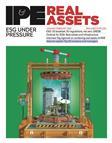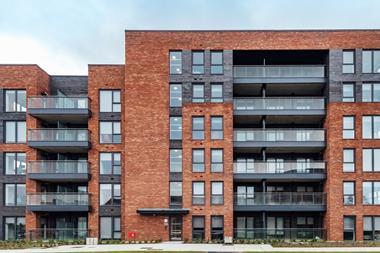Securitisation is bereft of liquidity but there are faint signs of hope. Managers should note that investors will not be impressed with over-complex structures. Lynn Strongin Dodds reports
Just as the European commercial mortgage-backed securities (CMBS) market had reached full throttle, the sub-prime crisis exploded, squashing its growth prospects. Issuance has ground to a halt and even obtaining old-fashioned bank lending can be a challenge. Pessimism prevails, with few expecting to see any action until next year.
Edward Panek, portfolio manager of Henderson Global Investors, notes: "Although I think the worst of the credit crisis is over, there will be a lot of potholes on the road to recovery. It will be two steps forward and one step back. No one is talking about 2008 in terms of any real primary issuance, as the reality is it will more likely be 2009 or 2010 before we see any significant activity.
"One problem was that many investors viewed the triple A or double A rated tranches of the CMBS issues as bullet-proof, but in the past nine months, that image has been severely dented. They did not fully understand the risk and complex nature of some of these structures."
In addition, as Andrew Currie, managing director of European structured finance at Fitch Ratings, points out, "Market conditions are not just CMBS specific but there is a general stigma attached to all structured finance investments. Investors have been scared off. Many started off in the residential mortgage-backed securities (RMBS) market and when they became more proficient they moved to CMBS. Now, they are backing away from all products that are more complicated."
Research from Birgit Specht, managing director in Citi's securitised products division, notes that pre-crisis, banks, structured investment vehicles and money market funds were the main buyers of the triple A tranches while credit and hedge/opportunity funds typically invested in the triple-B and below or unrated slices.
Some debt had also been placed outside the securitisation structure, with loans being ‘cut' into A/B-notes, with A enjoying a higher ranking to B. There was anecdotal evidence that the B note buyers in Europe were financial institutions such as banks and insurance companies as well as hedge and opportunity players. Initially, UK building societies dominated the bank camp but they were later joined by some French and German mortgage/specialists
in 2006-07.
Fast forward to today, and liquidity has been drained from the market, with few participants of any kind across the asset backed spectrum. Figures from the European Securitisation Forum (ESF) reveal that issuance of European asset-backed securities - loans secured on property, consumer finance and autos - had reached their height in 2007 at €461bn from about €78 bn in 2000. The ESF predicts volume will plunge 41% to €272bn this year.
As for CMBS, Daniel Kolter, managing director of Moody's Investors Service, notes that 2007 was a "year of two halves" for Europe, Middle East and Africa due to the credit crunch. Overall, 2007 CMBS volume was down by 15% to €59bn while the number of transactions dropped by 37% to 65 transactions.
The market was dominated by five countries, with Germany being the largest, accounting for 44.8% of issuance followed by the UK at 31%. The Netherlands was next on the list, with a relatively small percentage of 9.3% while France represented 7% and Italy clocked in a mere 2.8%. Not surprisingly, there has been little activity this year. First-quarter issuance plummeted by 77% to a mere €0.7 bn from the same period last year, according to Moody's research.
Investors are not only worried about the general malaise in the commercial property markets but they are also uncertain over refinancing opportunities for the more aggressively structured deals against the backdrop of widening spreads. High spreads result in CMBS being an unprofitable exit strategy for originators of commercial real estate loans, according to Kolter.
"The CMBS market is not functioning on the primary side. There has been reduced commercial real estate loan origination in light of the global de-leveraging process. Investor sentiment has been fragile across all structured finance products but the recent headlines of falling property prices in the UK and, to a lesser degree, Germany have added to the negative investor sentiment," he adds.
The other factor affecting activity is the dismantling of securitisation teams at investment banks. Altogether there have been more than 65,000 job cuts in the past year as the write-downs and losses related to the US mortgage debacle have spiralled to $387bn (€245bn).
Structured finance has been particularly hard hit and although it takes about a month to shut shop, it can take around 18 months to assemble a team together even if the market springs back to life.
Despite the gloomy forecasts, there are a few glimmers of hope on the horizon. In the past two months, there has been a trickle of deals in the RMBS market with banks securitising mortgages to use as funding collateral with central banks. Lloyds TSB recently completed a £11.5bn (€14.5bn) transaction, while the Royal Bank of Scotland's £3.7bn deal was issued by a special-purpose vehicle called Greenock Funding No. 1 PLC, and backed by a pool of prime residential mortgages and buy-to-let mortgages made by RBS and its National Westminster Home Loans unit.
Other similar deals done by European banks include HBOS, Bank of Ireland and Spanish commercial bank Bankinter (Banco Intercontinental Español). Participants are not getting too excited though because any true revival requires a significant narrowing of spreads and few believe that this will happen in the near future. In fact, the HBOS deal - the sale of £500m of RMBS - is a reflection of just how expensive the market has become. The triple-A rated bonds, which were sold at 85 basis points over three-month LIBOR, would probably have been priced at 10 basis points in the halcyon days.
Barry Osilaja, director, corporate finance, at Jones Lang LaSalle, adds: "There is pent up demand for fixed income products and CMBS is part of this asset class. As a result, I think the market will come back but in a smaller and less aggressive form. Growth will be slower. It will take time, though, as investors are currently waiting for the risk to be
repriced."
Kolter also expects that in future the average transaction will be smaller and that more issues will be backed by granular loan pools. In addition and not surprisingly, investors will be won over by prudent loan origination and simple deal structures.












